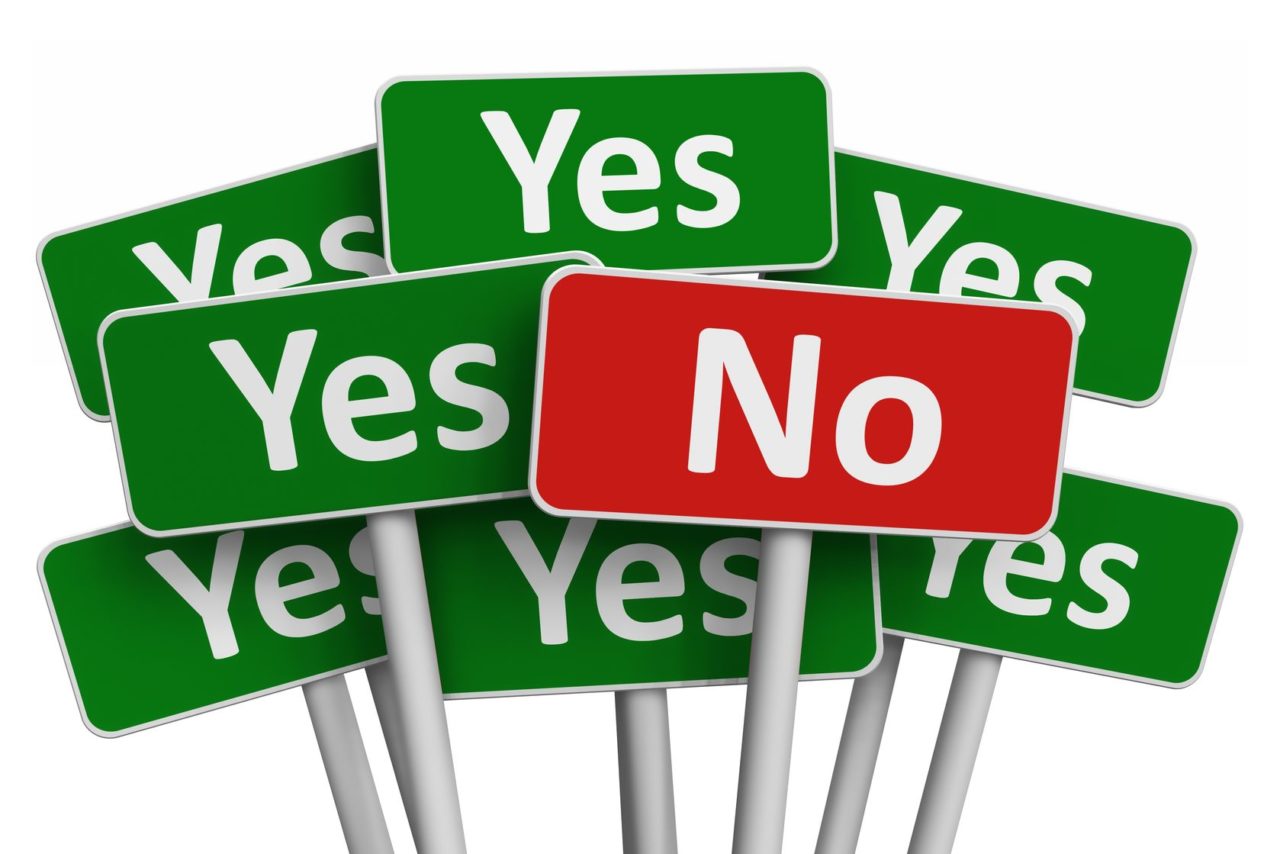
 We live in a culture of yes. In the business world, we are taught to engage, be assertive and never turn down an opportunity. All of this behavior results in a whole lot of yeses (and time commitments). After all, saying yes is fun; it often feels a lot better than saying no. To further compound the issue, most of us aim to please — our bosses, our coworkers and our teams. There is no doubt that saying yes to new challenges, ones that are outside of our comfort zone, can lead to heighten self-awareness and insightful gains in productivity.
We live in a culture of yes. In the business world, we are taught to engage, be assertive and never turn down an opportunity. All of this behavior results in a whole lot of yeses (and time commitments). After all, saying yes is fun; it often feels a lot better than saying no. To further compound the issue, most of us aim to please — our bosses, our coworkers and our teams. There is no doubt that saying yes to new challenges, ones that are outside of our comfort zone, can lead to heighten self-awareness and insightful gains in productivity.
However, there is a dark side to the resounding yes. All of those yeses can lead to burnout, where we over-commit our time, energy and focus to tasks that may not be worthy of our attention. Offering an automatic yes can even go against our gut feeling or instinct about what we should be doing. We become so caught up in saying yes, it can lead us down the wrong path. Learning to say no effectively can allow us to regain control and empower us to move forward. Yet, saying no is not always easy; it requires discipline and in some cases, a rather strong backbone.
Lets review some basic steps that lead to an effective yet eloquent no.
The first step to effectively saying no is breaking the yes cycle. Many of us are programmed to automatically say yes before we even consider what we’re truly committing to. Later, when we are trying to execute on our word, we may find ourselves scratching our heads and wondering why we ever agreed to this idea in the first place. It is extremely challenging to implement an idea you do not believe in or worse yet, do not even understand. Before you dole out the next enthusiastic yes, really think about what saying yes will mean. Do you have time for this commitment? Does it make sense for you to be involved? What does your gut tell you? Before saying yes (or no), engage in a healthy discussion or even negotiation. Asking some thoughtful questions helps demonstrate maturity and experience. Beyond that, it can lead to a much more effective outcome. Know what you are being asked to commit to before you commit.
Many people shy away from saying no because they are caught off guard and cannot find the right words in the moment. Have you ever found yourself rattling off excuses and floundering for the appropriate response? The last thing you want is to have your no viewed as awkward or negotiable. It’s a lot easier to say no if you have experience and feel comfortable doing it. Think of a few basic no responses to use in different scenarios and commit them to memory. These premeditated responses will serve as your go-to no script. Then, use them early in conversation and use them often.
While you may not feel comfortable brandishing a no response to the next major team initiative, you can learn to say no to little things first and build your way from there. Practice saying no with a pushy salesperson or overbearing solicitor. With every no, you will gain confidence. Some people even find it helpful to practice role playing saying no with a family member or friend until they feel more comfortable. There once was a man who practiced saying no to his dog, a lot, until it finally became second nature to him. It may sound silly, but a little practice can help break a knee-jerk yes habit.
If you still find yourself struggling to deliver an effective no, consider this approach. Professor Patrick and Henrik Hagtvedt conducted a study in the Journal of Consumer Research. They found that when people used the phrase “I don’t” as opposed to “I can’t” they were more effective in successfully saying no. A response that begins with “I don’t” leaves little room for negotiations. It also demonstrates an established protocol that must be followed. There is a sense of empowerment and confidence that accompanies “I don’t” statements. Whereas, “I can’t” can lead to lots of additional discussion and potential fumbling of the response.
Despite our best intentions, in more high stakes situations, people can find themselves saying yes because it seems like the obvious choice or the right choice. They ask themselves how could I possibly turn down this opportunity, even though it may go against what their heart is telling them to do. When everyone else thinks you would be crazy to say no, consider the TED talk titled The Art of Saying No by Kenny Nguyen.
In his talk, Nguyen argues that no is a very powerful word, and it can be used to protect us. When we are children, our caretakers must say no to keep us from harm’s way. As we mature, it is our job to learn to protect ourselves by saying no.
The next time you are faced with an opportunity, saying no may feel uncomfortable. Before the yes impulse takes over, think about how saying no could protect you… from over committing your time, from sacrificing the quality of your work, and from making a choice that isn’t right for you.










